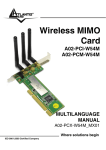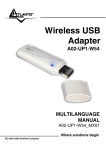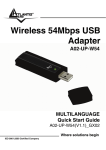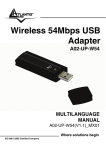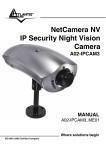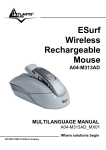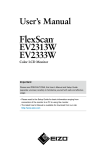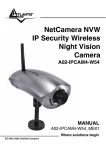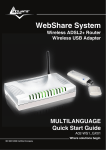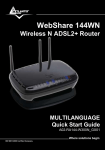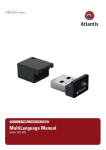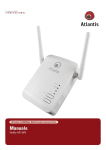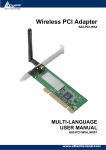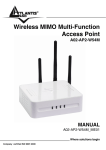Download Atlantis Land A02-PCI-W54M Camcorder User Manual
Transcript
Wireless MIMO Card A02-PCI-W54M A02-PCM-W54M MULTILANGUAGE Quick Start Guide A02-PCX-W54M_GX01 Where solutions begin ISO 9001:2000 Certified Company MultiLanguage Quick Start Guide ITALIANO Questo prodotto è coperto da garanzia Atlantis Land Fast-Swap della durata di 3 anni. Per maggiori dettagli in merito o per accedere alla documentazione completa in Italiano fare riferimento al sito www.atlantis-land.com. ENGLISH This product is covered by Atlantis Land 3 years Fast-Swap warranty. For more detailed informations please refer to the web site www.atlantis-land.com. For more detailed instructions on configuring and using this device, please refer to the online manual. FRANCAIS Ce produit est couvert par une garantie Atlantis Land Fast-Swap de 3 ans. Pour des informations plus détaillées, référez-vous svp au site Web www.atlantis-land.com. DEUTSCH Dieses Produkt ist durch die Atlantis Land 3 Jahre Fast-Swap Garantie gedeckt. Für weitere Informationen, beziehen Sie sich bitte auf Web Site www.atlantis-land.com. ESPAÑOL Este producto esta cubierto por Atlantis Land con una garantía Fast-Swap de 3 años. Para mayor información diríjase a nuestro sitio Web www.atlantis-land.com. MultiLanguage Quick Start Guide The award of the information is facultative, but its lack will prevent ATLANTIS LAND® from starting the Guarantee process requested. R R Reeegggiis issttteeerrryyyooouuurrrppprrroooddduuucccttt!!! w w w w m ww ww w..a .aatttlla laannntttiis iss---lla laannnddd..c .ccooom m Registration on the web site www.atlantis-land.com within 15 days from the purchase of the product dismiss the customer from showing a valid proof of purchase (Sale Receipt or Invoice) in case of the request of intervention. For further information we invite you to look at our web site at the section WARRANTY. Copyright The Atlantis Land logo is a registered trademark of Atlantis Land S.p.A. All other names mentioned mat be trademarks or registered trademarks of their respective owners. Subject to change without notice. No liability for technical errors and/or omissions. MultiLanguage Quick Start Guide INDEX ITALIANO 1 Wireless MIMO Card................................................................................................ 9 1.1 Requisiti di sistema.................................................................................... 9 1.2 Contenuto della confezione ......................................................................10 1.3 Panoramica Hardware ..............................................................................11 2. Installazione Driver e Utilità su Sistemi WIndows....................................................12 3. Installazione dell’hardware (A02-PCI-W54M)..........................................................14 4. Utility di configurazione della connessione Wireless ...............................................15 4.1 Introduzione..............................................................................................15 4.2 Utilizzare l’utility di configurazione ............................................................16 4.3 Connessione.............................................................................................16 5 Rimozione Driver ed Utility......................................................................................18 6 Problemi comuni e soluzioni ...................................................................................18 Disabilitare il gestore delle connessioni Wireless di Windows XP ...................18 Domande frequenti .........................................................................................19 7. Supporto Offerto .....................................................................................................20 ENGLISH 1 Wireless MIMO Card...............................................................................................23 1.1 System Requirements...............................................................................23 1.2 Package Contents ....................................................................................23 1.3 Product View ............................................................................................25 2 Software Installation................................................................................................26 3 Hardware Installation (A02-PCI-W54M) ..................................................................27 4. Wireless Network Utility ..........................................................................................28 4.1 Introduction...............................................................................................28 4.2 Using the Configuration Utility...................................................................29 5 Uninstallation ..........................................................................................................31 6 Troubleshooting ......................................................................................................31 Common Problems and Solutions...................................................................31 Disable “Windows XP Wireless Zero Configuration ........................................32 Frequently Asked Questions...........................................................................32 7 Product Support.......................................................................................................34 FRANCAIS 1 Wireless MIMO Card................................................................................................37 1.1 Besoin système ............................................................................37 1.2 Contenu de l’emballage ................................................................38 5 MultiLanguage Quick Start Guide 1.3 Carte ............................................................................................39 2 Installation sous Windows........................................................................................40 3 Installation Hardware (A02-PCI-W54M) ...................................................................40 4. Configuration ..........................................................................................................42 4.1 Logiciel de configuration ...........................................................................42 4.2 Logiciel de configuration ...........................................................................43 5 Supprimer les drivers et l’utilitaire ............................................................................44 6 Résolution de problèmes .........................................................................................44 Problèmes et Solutions...................................................................................44 Désactivation du controleur de Windows XP ..................................................45 Questions fréquentes......................................................................................45 7 Support ....................................................................................................................46 ESPAÑOL 1 Tarjeta Inalámbrica MIMO.......................................................................................50 1.1 Requisitos del sistema ..............................................................................50 1.2 Contenidos de la caja ...............................................................................51 1.3 Vista General del Producto .......................................................................52 2 Instalación del Software...........................................................................................53 3 Instalación del Hardware (A02-PCI-W54M) .............................................................55 4. Utilidad de la Red Inalámbrica ................................................................................56 4.1 Introducción ..............................................................................................56 4.2 Utilizar la aplicación de configuración .......................................................57 4.2.3 Connexión .............................................................................................58 5 Uninstallation - Desinstalación ................................................................................59 6 Problemas Comunes y Soluciones ..........................................................................59 Deshabilitar el gestor de conexiones de red inalámbricas de Windows XP ....60 Preguntas Frecuentes ....................................................................................60 7. Soporte Técnico......................................................................................................61 APPENDIX APPENDIX A ..............................................................................................................62 APPENDIX B ..............................................................................................................63 A02-PCX-W54M_GX01(V1.0 July 2006) 6 ITALIANO AVVERTENZE Abbiamo fatto di tutto al fine di evitare che nel testo, nelle immagini e nelle tabelle presenti in questo manuale, nel software e nell'hardware fossero presenti degli errori. Tuttavia, non possiamo garantire che non siano presenti errori e/o omissioni. Infine, non possiamo essere ritenuti responsabili per qualsiasi perdita, danno o incomprensione compiuti direttamente o indirettamente, come risulta dall'utilizzo del manuale, software e/o hardware. Il contenuto di questo manuale è fornito esclusivamente per uso informale, è soggetto a cambiamenti senza preavviso (a tal fine si invita a consultare il sito www.atlantisland.it o www.atlantis-land.com per reperirne gli aggiornamenti) e non deve essere interpretato come un impegno da parte di Atlantis Land spa che non si assume responsabilità per qualsiasi errore o inesattezza che possa apparire in questo manuale. Nessuna parte di questa pubblicazione può essere riprodotta o trasmessa in altra forma o con qualsiasi mezzo, elettronicamente o meccanicamente, comprese fotocopie, riproduzioni, o registrazioni in un sistema di salvataggio, oppure tradotti in altra lingua e in altra forma senza un espresso permesso scritto da parte di Atlantis Land spa. Tutti i nomi di produttori e dei prodotti e qualsiasi marchio, registrato o meno, menzionati in questo manuale sono usati al solo scopo identificativo e rimangono proprietà esclusiva dei loro rispettivi proprietari. Restrizioni di responsabilità CE/EMC Il prodotto descritto in questa guida è stato progettato, prodotto e approvato in conformità alle regole EMC ed è stato certificato per non avere limitazioni EMC. Se il prodotto fosse utilizzato con un PC non certificato, il produttore non garantisce il rispetto dei limiti EMC. Il prodotto descritto è stato costruito, prodotto e certificato in modo che i valori misurati rientrino nelle limitazioni EMC. In pratica, ed in particolari circostanze, potrebbe essere possibile che detti limiti possano essere superati se utilizzato con apparecchiature non prodotte nel rispetto della certificazione EMC. Può anche essere possibile, in alcuni casi, che i picchi di valore siano al di fuori delle tolleranze. In questo caso l’utilizzatore è responsabile della “compliance” con i limiti EMC. Il Produttore non è da ritenersi responsabile nel caso il prodotto sia utilizzato al di fuori delle limitazioni EMC. CE Mark Warning Questo dispositivo appartiene alla classe B. In un ambiente domestico il dispositivo può causare interferenze radio, in questo caso è opportuno prendere le adeguate contromisure. ATTENZIONE Lasciare almeno 30cm di distanza tra le antenne del dispositivo e l’utilizzatore. 7 ITALIANO Dichiarazione di Conformità Questo dispositivo è stato testato ed è risultato conforme alla direttiva 1999/5/CE del parlamento Europeo e della Commissione Europea, a proposito di apparecchiature radio e periferiche per telecomunicazioni e loro mutuo riconoscimento. Dopo l’installazione, la periferica è stata trovata conforme ai seguenti standard: EN 300.328(radio), EN 301 489-1, EN 301 489-17(compatibilità elettromagnetica) ed EN 60950(sicurezza). Questa apparecchiatura può pertanto essere utilizzata in tutti i paesi della Comunità Economica Europea ed in tutti i paesi dove viene applicata la Direttiva 1999/5/CE, senza restrizioni eccezion fatta per: Francia: Se si utilizza all’aperto tale dispositivo, la potenza in uscita è limitata (potenza e frequenza) in base alla tabella allegata. Per informazioni ulteriori consultare www.art-telecom.fr. Luogo Banda di Potenza (EIRP) Frequenze(MHz) Chiuso (senza restrizioni) 2400-2483,5 100mW(20dBm) Aperto 2400-2454 100mW(20dBm) 2454-2483,5 10mW(10dBm) Se l’uso di questa apparecchiatura in ambienti domestichi genera interferenze, è obbligo dell’utente porre rimedio a tale situazione. Italia: Questa periferica è conforme con l’Interfaccia Radio Nazionale e rispetta i requisiti sull’Assegnazione delle Frequenze. L’utilizzo di questa apparecchiatura al di fuori di ambienti in cui opera il proprietario, richiede un’autorizzazione generale. Per ulteriori informazioni si prega di consultare: www.comunicazioni.it. 8 ITALIANO La ringraziamo per aver scelto la Wireless MIMO Card, la via più semplice per il Wireless networking. Questo manuale è inteso come una guida rapida, pertanto per ulteriori dettagli sulla configurazione fare riferimento al manuale esteso presenti sul CDRom allegato. 1 Wireless MIMO Card La Wireless MIMO Card (IEEE802.11g a 54Mbps), consente ad utenti dotati di apparati wireless di navigare e/o condividere files in piena libertà e sicurezza (grazie anche all'adozione del robusto protocollo WPA/WPA2). Le 3 antenne (rimovibili R-SMA nella scheda PCI) da 2 dBi e la tecnologia MIMO XR™ permettono inoltre sia una copertura enormemente superiore rispetto alle normali reti IEEE802.11g che un throughput decisamente più uniforme (la presenza di zone morte verrà decisamente ridimensionata). La tecnologia Packet-Overdrive ™ infine permette di ottenere prestazioni velocistiche importanti rendendo l’apparato ideale anche per le applicazioni più impegnative (streaming Video HD). Con questo Adapter sarà possibile muoversi all’interno del proprio ufficio o da una stanza all’altra della propria casa senza mai disconnettersi dalla rete. Questo prodotto è compatibile con i sistemi Windows® XP/2000/ME/98SE ed è in grado di funzionare in modalità Ad-Hoc (computer-computer), in modalità in Infrastructure (computer ad access point) ed anche in modalità Access Point. 1.1 Requisiti di sistema Prima di procedere con l’installazione del prodotto verificare di disporre dei seguenti requisiti: PC desktop con uno slot PCI 2.1/2.2 libero (A02-PCI-W54M) Portatile con uno slot PCMCIA CardBus 32 bit Type II libero (A02-PCM-W54M) Processore Intel® Pentium®III 600Mhz o compatibile con 128 MB RAM Sistema operativo Windows 98SE/ME/2000/XP e Linux 15MB di spazio libero su disco Lettore CD-Rom Il prodotto è stato testato con kernel 2.4 e 2.6. Atlantis Land non garantisce che il dispositivo funzioni su distribuzioni/kernel diverse da quelle elencate né, dato il vasto numero di combinazioni, potrà offrire supporto. Si invita a tal fine a reperire gli ultimi driver direttamente sul sito del produttore del chipset (www.ralink.com.tw). 9 ITALIANO 1.2 Contenuto della confezione Prima di utilizzare il prodotto verificare che la confezione contenga i seguenti oggetti: Una Wireless MIMO Card 3 antenne esterna da 2 dBi (A02-PCI-W54M) Una guida rapida multilingua Un CD contenente driver, utility e manuale dell’utente 10 ITALIANO 1.3 Panoramica Hardware 11 ITALIANO 2. Installazione Driver e Utilità su Sistemi WIndows Questa sezione descrive la procedura di installazione di driver e utility della Wireless MIMO PCI/PCMCIA Card. Seguire le istruzioni passo a passo per installare driver ed utility. Se si utilizza un sistema Windows 98SE o Me è necessario reperire il cd di installazione del sistema operativo, potrebbe essere richiesto in fase di installazione. Per lanciare direttamente i driver/utility, una volta inserito il CD nell’apposito lettore, cliccare sull’icona setup (CDRom:\driver\setup.exe) o utilizzare l’interfaccia grafica visualizzata a video. Non inserire la scheda PCI/PCMCIA nel PC prima di aver installato i driver/utilità. Seguire le istruzioni a video per portare a termine la procedura. Cliccare su Yes per proseguire. 12 ITALIANO Spuntare la voce Ralink Configuration Tool per utilizzare l’utility a corredo o Microsoft Zero Configuration Tool per utilizzare l’utility integrata nel sistema operativo. Cliccare poi su Next. Scegliere Optimized for WiFi mode (scelta raccomandata in caso si riscontrino di problematiche di interoperabilità) oppure Optimized for performance mode (scelta raccomandata). Cliccare poi su Next. A questo punto apparirà la scritta in cui viene richiesto di inserire la scheda PCMCIA. Una volta inserita verrà riconosciuta ed installata automaticamente. 13 ITALIANO Per terminare la procedura di installazione scegliere Yes, I want to restart my computer now e cliccare poi su Finish. 3. Installazione dell’hardware (A02-PCI-W54M) Lo schema seguente fornisce alcune informazioni in merito all’installazione della Wireless PCI Card, la procedura è utilizzabile con la maggior parte dei PC in commercio. Per maggiori informazioni fare riferimento al manuale della mainboard. Step 1. Spegnere il PC e rimuovere la copertura esterna. Localizzare uno slot PCI libero. Step 2. Posizionare il Wireless PCI Adapter sullo slot PCI e premere per inserirlo. 14 ITALIANO Step 3. Step 4. Step 5. Dopo aver bloccato correttamente la scheda PCI con l’apposita vite richiudere la copertura esterna del PC. Connettere le 3 antenne esterne avvitandole delicatamente sino a giungere a fine corsa. Accendere il PC. 4. Utility di configurazione della connessione Wireless 4.1 Introduzione Con il driver è stato installato anche un applicativo (se durante l’installazione è stata spuntata l’opzione Ralink Configuration Tool) che permette in modo facile, chiaro e veloce di configurare le impostazioni della connessione Wireless. Una volta terminata l’installazione, è possibile vedere l’icona ( taskbar. )in figura nella Qualora l’icona sia di colore: • Verde( ): Indica un ottimo livello segnale e la connessione attiva. • Gialla( ): Indica un buon livello segnale e la connessione attiva. 15 ITALIANO • Rossa( • Icona Rossa con Barra Rossa( • Icona Nera con Barra Nera( ): Indica un basso livello segnale e la connessione attiva. ): Connessione non attiva. ): Scheda non rilevata. Andando sull’icona e premendo il tasto destro del mouse verrà mostrato un menu contenente 4 scelte: • Launch Config Utilities • Use Zero Configuration as Configuration Utility • Switch to AP mode • Exit Per utilizzare l’utility Zero Configuration di Microsoft per la configurazione Wireless cliccare sulla voce Use Zero Configuration as Configuration Utility. Una volta in questa modalità è possibile tornare ad utilizzare l’utility semplicemente cliccando sulla voce Use RaConfig as Configuration Utility. 4.2 Utilizzare l’utility di configurazione Cliccare due volte sull’icona dell’utility di configurazione per avviarla, altrimenti cliccare sull’ icona con il tasto destro e selezionare Launch Configuration Utility. Grazie a questa utility è possibile configurare e monitorare nel dettaglio la scheda PCI/PCMCIA Wireless MIMO. L’Utility di configurazione include 7 tabs: Profile, Link Status, Site Survey, Statistics, Advanced, QoS ed About. 4.3 Connessione (Site Survey) In questa pagina è possibile vedere tutti gli AP disponibili nelle vicinanze rilevati del client. 16 ITALIANO Rescan: Cliccare per ottenere la lista di tutti gli AP disponibili nelle vicinanze rilevati dal client. Connect: Cliccare (dopo aver evidenziato un AP) per connettere il client all’AP selezionato. La visualizzazione dell’icona ( ) indica l’avvenuta connessione con l’AP selezionato. Add to Profile: Cliccare (dopo aver evidenziato un AP) e impostare tutti i campi opportuni (Nome Profilo e cifratura) per creare un nuovo profilo. Se l’AP selezionato ha la cifratura abilitata è necessario configurare i parametri di accesso adeguati nella schermata Authentication and Security (WEP/WPA/WPA2) per avere accesso alla rete wireless. Per ulteriori dettagli consultare la documentazione completa su CDRom. 17 ITALIANO 5 Rimozione Driver ed Utility Per disinstallare la Wireless MIMO PCI/PCMCIA Card effettuare la seguente procedura: • Chiudere eventuali applicazioni attive • Cliccare sull’icona Risorse del Computer ed andare in Pannello di controllo. • Cliccare sull’icona Installazioni Applicazioni, evidenziare Ralink Wireless LAN Card e cliccare su Aggiungi/Rimuovi, confermare poi la procedura di disinstallazione (alternativamente in Programmi->Ralink Wireless-> Uninstall RT-6x). • Cliccare su Remove ALL [oppure su Overwrite the older version install without remove]. • Al termine della procedura scegliere Yes, I want to restart my computer now e cliccare poi su Finish. • A questo punto, una volta spento il PC, è possibile rimuovere la scheda. 6 Problemi comuni e soluzioni Questo capitolo fornisce alcune soluzioni in merito ai problemi nei quali si potrebbe incorrere durante l’installazione e l’utilizzo del prodotto. Leggere le seguenti indicazioni per risolvere eventuali problemi. 1. Il personal computer non rileva la periferica. Accertarsi che la scheda non sia fisicamente danneggiata. Accertarsi che la scheda sia correttamente inserita nello slot PCI/PCMCIA. Provare uno slot PCI/PCMCIA differente. 2. Non è possibile accedere a nessuna risorsa Wireless Assicurarsi che il PC sia acceso Assicurarsi che le impostazioni di rete wireless siano corrette. Verificare con l’amministratore di rete SSID, canale utilizzato, ecc. Disabilitare il gestore delle connessioni Wireless di Windows XP In Windows XP è raccomandato utilizzare il software di gestione delle connessioni senza fili fornito a corredo del prodotto. Una volta conclusa l’installazione del driver seguire i seguenti passi per disabilitare il gestore delle reti wireless integrato in Windows XP 1 Aprire il “Pannello di controllo” e cliccare su “Connessioni di rete”. 18 ITALIANO 2 3 Cliccare con il tasto destro sull’ icona “Connessione di rete senza fili” relativa alla scheda di rete PCI/PCMCIA, e selezionare “Proprietà”. Selezionare il tab “Reti senza fili”, e deselezionare la voce “Usa Windows per configurare le impostazioni della rete senza fili”, cliccare quindi su “OK”. Domande frequenti 1. Posso avviare un’ applicazione da un computer remoto presente sulla rete wireless? Questo dipende direttamente dall’applicazione stessa, se è stata progettata per lavorare in rete (non fa differenza che sia wireless o cablata) non ci sarà alcun problema. 2. Posso giocare in rete con gli altri computer presenti sulla WLAN? Si, se il gioco è dotato di funzionalità multiplayer in rete. 3. Cos’è lo Spread Spectrum? La trasmissione Spread Spectrum si basa sulla dispersione dell’informazione su una banda molto più ampia di quella necessaria alla modulazione del segnale disponibile. Il vantaggio che si ottiene da questa tecnica di modulazione è infatti una bassa sensibilità ai disturbi radioelettrici anche per trasmissioni a potenza limitata. Questa caratteristica è ovviamente preziosa quando si devono trasmettere dei dati. 4. Cosa sono DSSS e FHHS? DSSS (Direct-Sequence Spread-Spectrum): E' una particolare tecnologia di trasmissione per la banda larga che consente di trasmettere ogni bit in maniera ridondante. E' adatta in particolare per la trasmissione e la ricezione di segnali deboli. FHHS (Frequency Hopping Spread Spectrum): è una tecnologia che permette la condivisione tra più utenti di uno stesso insieme di frequenze. Per evitare interferenze tra periferiche dello stesso tipo le frequenze di trasmissione cambiano sino a 1.600 volte ogni secondo. 5. Le informazioni inviate via wireless possono essere intercettate? La scheda PCI/PCMCIA offre funzionalità di crittografia WEP fino a 128 bit, ciò provvede a rendere sicure le trasmissioni dati wireless. L’utilizzo del WPA rende ancora più sicura la trasmissione wireless. 6. Cosa è il WEP? WEP è la sigla di Wired Equivalent Privacy, un protocollo di sicurezza per le reti locali senza fili (WLAN) definito dallo standard 802.11b. 7. Cosa è la modalità Infrastructure? Nella configurazione Infrastructure una rete WLAN e una rete WAN comunicano tra loro tramite un access point. 8. Cosa è il Roaming? 19 ITALIANO Il Roaming è la capacità di un utente che possiede un computer portatile di comunicare senza interruzioni mentre si muove liberamente all’interno di una rete wireless la cui estensione è stata incrementata grazie all’utilizzo di più access point. 9. Cosa è la banda ISM? Questa frequenza è stata messa a disposizione dalla FCC, su richiesta delle aziende che intendevano sviluppare soluzioni wireless per l'uso civile quotidiano ed è generalmente contraddistinta dalla sigla ISM band (Industrial, Scientific and Medical). In questa frequenza operano solo dispositivi industriali, scientifici e medici a basse potenze. 10. Cosa è lo standard IEEE 802.11g ? Il nuovo standard 802.11g opera alla frequenza di 2,4 GHz e quindi è pienamente compatibile con la più diffusa versione b. Il vantaggio è che consente una velocità di trasferimento di 54 Mbps, cinque volte superiore allo standard 802.11b. 7. Supporto Offerto Per qualunque altro problema o dubbio (prima è necessario conoscere tutti i parametri usati nella rete wireless) è possibile contattare l’help desk telefonico (02/93907634) gratuito di Atlantis Land che fornirà assistenza da lunedì al giovedì dalle 9:00 alle 13:00 e dalle 14:00 alle 18:00 ed il venerdì dalle 9:00 alle 13:00. E’ possibile anche utilizzare il fax (02/93906161) la posta elettronica ([email protected] oppure [email protected]) per esporre eventuali domande o problemi. Atlantis Land SpA Viale De Gasperi 122 20017 Mazzo di Rho (MI) Tel: +39.(0)2.93906085 (Fax: +39.(0)2.93906161) Help Desk :+39.(0)2.93907634 20 ENGLISH Copyright Statement No part of this publication may be reproduced, stored in a retrieval system, or transmitted in any form or by any means, whether electronic, mechanical, photocopying, recording or otherwise without the prior writing of the publisher. Windows™ 98SE/2000/ME/XP are trademarks of Microsoft® Corp. Pentium is trademark of Intel. All copyright reserved. The Atlantis Land logo is a registered trademark of Atlantis Land SpA. All other names mentioned mat be trademarks or registered trademarks of their respective owners. Subject to change without notice. No liability for technical errors and/or omissions. Wireless LAN, Health and Authorization for use Radio frequency electromagnetic energy is emitted from Wireless LAN devices. The energy levels of these emissions however are far much less than the electromagnetic energy emissions from wireless devices like for example mobile phones. Wireless LAN devices are safe for use frequency safety standards and recommendations. The use of Wireless LAN devices may be restricted in some situations or environments for example: ·On board of airplanes, or ·In an explosive environment, or ·In case the interference risk to other devices or services is perceived or identified as harmful In case the policy regarding the use of Wireless LAN devices in specific organizations or environments (e.g. airports, hospitals, chemical/oil/gas industrial plants, private buildings etc.) is not clear, please ask for authorization to use these devices prior to operating the equipment. Regulatory Information/disclaimers Installation and use of this Wireless LAN device must be in strict accordance with the instructions included in the user documentation provided with the product. Any changes or modifications made to this device that are not expressly approved by the manufacturer may void the user’s authority to operate the equipment. The Manufacturer is not responsible for any radio or television interference caused by unauthorized modification of this device, of the substitution or attachment. Manufacturer and its authorized resellers or distributors will assume no liability for any damage or violation of government regulations arising from failing to comply with these guidelines. 21 ENGLISH CE Mark Warning This is a Class B product. In a domestic environment, this product may cause radio interference, in which case the user may be required to take adequate measures. CE in which Countries where the product may be used freely: Germany, UK, Italy, Spain, Belgium, Netherlands, Portugal, Greece, Ireland, Denmark, Luxembourg, Austria, Finland, Sweden, Norway and Iceland. France: except the channel 10 through 13, law prohibits the use of other channels. CE/EMC Restriction of Liability The product described in this handbook was designed, produced and approved according to the EMC-regulations and is certified to be within EMC limitations. If the product is used in an uncertified PC, the manufacturer undertakes no warranty in respect to the EMC limits. The described product in this handbook was constructed, produced and certified so that the measured values are within EMC limitations. In practice and under special circumstances, it may be possible, that the product may be outside of the given limits if it is used in a PC that is not produced under EMC certification. It is also possible in certain cases and under special circumstances, which the given EMC peak values will become out of tolerance. In these cases, the user himself is responsible for compliance with the EMC limits. Declaration of Conformity This equipment has been tested and found to comply with Directive 1999/5/CE of the European Parliament and of the Council on radio equipment and telecommunications terminal equipment and the mutual recognition of their conformity. After assessment, the equipment has been found to comply with the following standards: EN 300.328 (radio), EN 301 489-1, EN 301 489-17 (electromagnetic compatibility) and EN 60950 (safety). This equipment may be used in all European Union contries and in all countries applying Directive 1999/5/CE, without restriction, with the exception of the following countries: France:When this equipment is used outdoors, output power is limited to within the frequency bans listed on the chart. For more info, consult the website www.arttelecom.fr. Location Frequency Band (MHz) Power (EIRP) Indoor (no restriction) 2400-2483,5 100mW(20dBm) Outdoor 2400-2454 100mW(20dBm) 2454-2483,5 10mW(10dBm) Italy: For more info, consult the website www.comunicazioni.it 22 ENGLISH Thank you for purchasing the Wireless MIMO Card that provides the easiest way to wireless networking. For more detailed instructions on configuring and using the Wireless MIMO Card, please refer to the online manual. 1 Wireless MIMO Card The Wireless PCI/PCMCIA MIMO Card (hereafter called the Adapter) is a highefficiency wireless LAN Card for wireless networking at home, in office or in public places. The data rate can be up to 54 Mbps and auto-negotiated to 48, 36, 24, 18, 12, 9, 6Mbps (IEEE 802.11g), or 11, 5.5, 2, 1Mbps (IEEE802.11b). With the Adapter, you can roam between conference room and office without being disconnected the LAN cables; in addition, sharing files and printers can be easy tasks. The Wireless MIMO PCI Card is available to Microsoft Windows operating systems (Windows® XP/2000/ME/98SE) and can be integrated into networking with either Adhoc mode (computer-to-computer, without an Access Point), Infrastructure mode (computer-to-access point, an Access Point is required) or Access Point Mode. The device offers quick and easy access among wired network and wireless network. The Wireless MIMO PCI Card also supports WPA/WPA2 security, it increases the level of data protection and access control for Wireless LAN. MIMO XR™ and 3 x 2 dBi Antennas (Reverse-SMA for A02-PCI-W54M) provide extended coverage and low throughput fluctuations. Last but not least Packet-Overdrive™ technology offers an high throughput for HD Video Streaming. 1.1 System Requirements Before installing the Adapter, your PC should meet the following: Desktop PC with available PCI2.1/2.2 slot Notebook with available PCMCIA CardBus Type II 32 bit slot Intel® Pentium®III 600Mhz or compatible processor with 128MB RAM Windows 98SE/ME/2000/XP or Linux operating system Minimum 15 Mbytes free disk space for installing the driver and utilities CD-Rom drive 1.2 Package Contents Unpack the package and check all the items carefully. If any item contained is damaged or missing, please contact your local dealer as soon as possible. Also, keep 23 ENGLISH the box and packing materials in case you need to ship the unit in the future. The package should contain the following items: One Wireless MIMO Card 3 external 2 dBi antenna (A02-PCI-W54M) One Quick Start Guide One CD with driver/utilities and user’s manual 24 ENGLISH 1.3 Product View 25 ENGLISH 2 Software Installation This section describes the procedures of installing the driver and utility. Follow the instruction step by step to finish the installation. If you use Windows® 98SE/ME, please prepare the Windows® Setup CD at hand before installing the driver; because the system will ask you to insert the Setup CD to copy files during the installation. Start Windows. Insert the driver CD into your CD-Rom drive. Go to your Windows Start menu and choose Run, type “CDRom:\Driver\Setup.exe” in the dialog box and click OK. Simply follow the instructions below which outline what you needto do. Click Yes. In the next windows choose Ralink Configuration Tool, then click Next. Chose Optimazed for Wi-Fi mode, then click Next. Please plug Wirless MIMO PCMCIA Card cable into PCMCIA Slot, it will be recognized and auto installed. 26 ENGLISH In the last Windows please select Yes, I want to restart my computer, then click on Finish. 3 Hardware Installation (A02-PCI-W54M) The following diagrams provide you a basic installation for the Adapter, which is suitable for most desktop PCs. For more information about the PCI slot, please refer to the user's manual of your main board. Step 1. Power off the computer, and then remove the computer cover. Locate the available PCI slot on your main board. Step 2. Put the Adapter directly over the PCI slot and press it into the slot firmly. 27 ENGLISH Step 3. Step 4. Step 5. Replace the computer cover after securing the Adapter with a bracket screw. Gently connect the 3 external antennas to the connectors on the Adapter’s bracket. Power on your PC. 4. Wireless Network Utility 4.1 Introduction After installing the driver, the Adapter provides a convenient and powerful utility that allows you to set up, configure, and know your networking status easily and clearly. You will see the icon( ) on the Windows task bar when you finish the installation. Besides, the small icon will change color to reflect current wireless network connection status. The status indicates as follow: • : Indicate Connected and Signal Strength is Good. • : Indicate Connected and Signal Strength is Normal. 28 ENGLISH • : Indicate Connected and Signal Strength is Weak. • : Indicated not connected yet. • : Indicated wireless NIC not detected. When You click on this icon in the Windows task bar You can see 4 different links: • Launch Config Utilities • Use Zero Configuration as Configuration Utility • Switch to AP mode • Exit In windows XP, it provides wireless configuration utility named “windows zero configuration” which provides basic configuration function for Wirless MIMO Card. Currently, Ralink’s utility provides WPA-PSK supplicant’s functionality. If user required WPA function. Please select WZC as main utility. To make it easier for user to select the correct utility. RaConfig will let user make the selection when it first ran after XP boot. Click the icon of will bring up the selection window and let user make the selection. When coexisting with WZC, RaConfig only provides monitoring function, such as link status, site surveying, statistic counters and advance feature status. 4.2 Using the Configuration Utility Double-click the Wireless LAN icon (or right-click and then select Launch Config Utilities) to launch the Configuration Utility. With the Wireless PCI//PCMCIA Adapter utility, users can configure all the functions provided by the Wireless Monitor Utility. Double-click the utility icon that appears in the taskbar. 29 ENGLISH The Wireless Monitor Utility includes seven tabs: Profile, Link Status, Site Survey, Statistics, Advanced, QoS and About. 4.3 Connect Under the site survey page, system will display the information of surrounding APs from last scan result. List information’s include SSID, BSSID, Signal, Channel, Encryption algorithm, and Network type as picture shown. Rescan: Issue an rescan command to wireless NIC to update information on surrounding wireless network. Connect: Command to connect to the selected network. Add to Profile: select an AP profile, click Add to Profile. It will bring up profile page and save user’s setting to a new profile. 30 ENGLISH If selected AP supports WEP or WPA/WPA2 You have to chose Authentication and Security tab in order to connect to the wireless network. For more detailed instructions on configuring and using the Wireless MIMO Card, please refer to the online manual. 5 Uninstallation To uninstall the Wireless MIMO NIC Card, go to the Control Panel of your system. • Open the Add/Remove Programs. • Select the Ralink Wireless Lan Card in the Add/Remove Programs and then click on the Remove. • Click on Remove ALL [or Overwrite the older version install without remove]. • Then chose Yes, I want to restart my computer and click Finish. • Now You can remove the Card. 6 Troubleshooting Common Problems and Solutions This chapter provides solutions to problems that may occur during the installation and operation of the WLAN 802.11g PCI/PCMCIA Adapter. Read the descriptions below to solve your problems. 1. My computer cannot find the Adapter Make sure the Adapter has no physical damage. Make sure the Adapter is properly inserted in the PCI/PCMCIA slot. Try the Adapter in other PCI/PCMCIA slots. Try another Adapter in that particular PCI/PCMCIA slot. 2. Cannot access any network resources from the computer.Make sure that the notebook PC is powered on. Make sure that the notebook PC is powered on. Make sure that the Cardbus is configured with the same SSID and security options as the other computers in the infrastructure configuration. 31 ENGLISH Disable “Windows XP Wireless Zero Configuration In Windows XP, it is recommended that you use the WLAN 802.11g Utility. Right after the installation, before opening the Utility, please follow the steps below to disable the Windows XP Zero Configuration: 1 Go to “Control Panel” and double click “Network Connections”. 2 Right-click “Wireless Network Connection” of WLAN 802.11gWireless LAN, and select “Properties”. 3 Select “Wireless Networks” tab, and uncheck the check box of “Use Windows to configure my wireless network settings”, and then click “OK”. Frequently Asked Questions 1. Can I run an application from a remote computer over the wireless network? This will depend on whether or not the application is designed to be used over a network. Consult the application’s user guide to determine if it supports operation over a network. 2. Can I play computer games with other members of the wireless network? Yes, as long as the game supports multiple players over a LAN (local area network). Refer to the game’s user guide for more information. 3. What is Spread Spectrum? Spread Spectrum technology is a wideband radio frequency technique developed by the military for use in reliable, secure, mission-critical communications systems. It is designed to trade off bandwidth efficiency for reliability, integrity, and security. In other words, more bandwidth is consumed than in the case of narrowband transmission, but the trade-off produces a signal that is, in effect, louder and thus easier to detect, provided that the receiver knows the parameters of the spread-spectrum signal being broadcast. If a receiver is not tuned to the right frequency, a spread-spectrum signal looks like background noise. There are two main alternatives, Direct Sequence Spread Spectrum (DSSS) and Frequency Hopping Spread Spectrum (FHSS). 4. What is DSSS? What is FHSS? And what are their differences? Frequency-Hopping Spread-Spectrum (FHSS) uses a narrowband carrier that changes frequency in a pattern that is known to both transmitter and receiver. Properly synchronized, the net effect is to maintain a single logical channel. To an unintended receiver, FHSS appears to be short-duration impulse noise. Direct-Sequence SpreadSpectrum (DSSS) generates a redundant bit pattern for each bit to be transmitted. This bit pattern is called a chip (or chipping code). The longer the chip, the greater the probability that the original data can be recovered. Even if one or more bits in the chip 32 ENGLISH are damaged during transmission, statistical techniques embedded in the radio can recover the original data without the need for retransmission. To an unintended receiver, DSSS appears as low power wideband noise and is rejected (ignored) by most narrowband receivers. 5. Would the information be intercepted while transmitting on air? WLAN features two-fold protection in security. On the hardware side, as with Direct Sequence Spread Spectrum technology, it has the inherent security feature of scrambling. On the software side, WLAN offers the encryption function (WEP) to enhance security and access control. 6. What is WEP? WEP is Wired Equivalent Privacy, a data privacy mechanism based on a 64-bit or 128bit shared key algorithm, as described in the IEEE 802.11 standard. 7. What is infrastructure mode? When a wireless network is set to infrastructure mode, the wireless network is configured to communicate with a wired network through a wireless access point. 8. What is roaming? Roaming is the ability of a portable computer user to communicate continuously while moving freely throughout an area greater than that covered by a single access point. Before using the roaming function, the workstation must make sure that it is the same channel number with the access point of dedicated coverage area. 9. What is ISM band? The FCC and their counterparts outside of the U.S. have set aside bandwidth for unlicensed use in the ISM (Industrial, Scientific and Medical) band. Spectrum in the vicinity of 2.4 GHz, in particular, is being made available worldwide. This presents a truly revolutionary opportunity to place convenient high-speed wireless capabilities in the hands of users around the globe. 10. What is the IEEE 802.11g standard? Approved in June, 2003 as an IEEE standard for wireless local area networks (WLANs), 802.11g offers wireless transmission over relatively short distances at up to 54 megabits per second (Mbps) compared with the 11 megabits per second of the 802.11b (Wi-Fi) standard. Like 802.11b, 802.11g operates in the 2.4 GHz range and is thus compatible with it. 33 ENGLISH 7 Product Support If you have any problems with the Wireless MIMO PCI/PCMCIA Card, please consult this manual. If you continue to have problems you should contact the dealer where you bought this device. If you have any other questions you can contact the Atlantis Land company directly at the following address: Atlantis Land SpA Viale De Gasperi, 122 20017 Mazzo di Rho(MI) Tel: +39. 02.93906085, +39. 02.93907634(help desk) Fax: +39. 02.93906161 Email: [email protected] or [email protected] WWW: http://www.atlantis-land.com 34 FRANCAIS Copyright Copyright. 2002 est la propriété de cette société. Tout droits réservés. Sont interdites, la reproduction, la transmission, la transcription, la mémorisation dans un système de sauvegarde où la traduction dans une autre langue ou en langage informatique quels qu’ils soient, de la présente publication, sous quelque forme que ce soit ou quelque en soit le moyen, électronique, mécanique, magnétique, optique, chimique, manuel ou de tout autre genre, sans avoir obtenu préalablement l’autorisation de notre entreprise. Non-responsabilité La présente entreprise n’admet ni requêtes ni de garantie, explicites ou implicites, au sujet du contenu et de manière spécifique exclue la possibilité de garantie, communicabilité ou adaptabilité pour des finalités particulières. Le logiciel décrit dans le présent manuel est vendu ou concédé en licence “tel quel”. Si les programmes devaient présenter des problèmes après l’achat, l’acquéreur (et non pas la présente entreprise, son distributeur ou concessionnaire) est tenu de prendre en charge tous les coûts de manutention ainsi que les coûts dus à des dommages accidentels ou des conséquences dérivants d’un défaut du logiciel. La présente entreprise se réserve en outre le droit de revoir le contenu de cette publication et d’y apporter des modifications de temps en temps, sans obligation d’informer les utilisateurs de ces changements. Nous avons fait tout notre possible afin d’éviter la présence d’erreurs dans le texte, les images, les tableaux présents dans ce manuel et dans le Cd-Rom. Cependant, nous ne pouvons pas garantir l’absence totale d’erreurs et/ou d’omissions, nous vous remercions donc de nous les signaler et vous prions de nous en excuser. Enfin, nous ne pouvons être tenus pour responsables dans quelque perte que ce soit, dommage ou incompréhension à la suite directe ou indirecte de l’utilisation de notre manuel, le logiciel Cd-Rom et/ou disque dur. Toutes les marques ou noms de produits mentionnés dans le présent manuel sont des marques commerciales et/ou brevetées par leurs propriétaires respectifs. Marquage CE Cet appareil, qui appartient à la Classe B peut causer des interférences radio, dans ce cas nous vous invitons à prendre les contre-mesures appropriées. ATTENTION Laisser au moins 30 cm de distance entre les antennes du dispositif et les utilisateurs. Domaine de régulation Chaque pays utilise des bandes de fréquences fixées par cet organisme, l’utilisateur final doit donc s’assurer du bon réglage de son AP sur un canal autorisé dans son pays. 35 FRANCAIS Déclaration de Conformité Cet appareil a été testé et est conforme à la Directive 1999/5/CE du Parlement européen et du Conseil concernant les équipements hertziens et les équipements de terminaux de télécommunications et la reconnaissance mutuelle de leur conformité. Après évaluation du matériel, celui-ci est conforme aux normes suivantes : EN 300.328 (radio), EN 301 489-1, EN 301 489-17(compatibilité électromagnétique) et EN 60950 (sécurité). Ce matériel peut être utilisé dasn tous les pays de l’Union Européenne et dans tous les pays appliquant la Directive 1999/5/CE, sans limitations, à l’exception des pays suivants : France : En cas d’utilisation de ce matériel en extérieur, la puissance de sortie est limitée dans les plages de fréquences ci-dessous. Pour de plus amples informations, consultez le site de l’ART : www.art-telecom.fr Site Intérieur (aucune restriction) Extérieur Plage de fréquences (MHz) 2400-2483,5 2400-2454 2454-2483,5 Puissance (EIRP) 100mW(20dBm) 100mW(20dBm) 10mW(10dBm) Italie : Cet appareil est conforme à l’interface radio nationale et aux exigences de la table d’allocation des fréquences. L’utilisation de ce produit sans fil en dehors du cadre de la propriété de l’acquéreur nécessite une autorisation générale. Pour da plus amples informations, consultez le site www.comunicazioni.it 36 FRANCAIS Félicitations pour avoir choisit ceproduit. Ce manuel a été rédigé pour une utilisation avancée du Wireless MIMO Card, le terme Carte sera utilisé dans ce manuel pour désigner cet appareil. Pour plus de précisions, tant sur les méthodes de configuration que sur le paramétrage avancé, reportez-vous au Manuel sous format électronique (PDF) sur le CD Rom fourni. 1 Wireless MIMO Card La Carte PCI/PCMCIA est une carte réseau Sans fil utilisable à la maison, au bureau ou dans des lieux publics. Ce produit gère la vitesse de transfert 54 Mbps et peut autonégocier les vitesses de 48, 36, 24, 18, 12, 9, 6 Mbps (IEEE 802.11g) ou 11, 5.5, 2, 1 Mbps (IEEE802.11b). Les 3 antennes (amovibles R-SMA dans la carte PCI) de 2 dBi chacune et le MIMO XR™ assurent une couverture étendue avec un débit constant permanent. Avec la technologie Packet-Overdrive ™ enfin le dispositif permets d’envoyer sur le réseau sans fil aussi du video HD. Avec ces fonctions intégrées, le produit vous donne la flexibilité nécessaire pour configurer le dispositif de manière à répondre aux besoins de votre environnement. Les chipsets supportent le Wi-Fi Protected Access (WPA/WPA2) et le nouveau standard de sécurité IEEE802.11i en hardware, ainsi que le moteur d’encryptage haute vitesse sans dégradation des performances. Les fonctions de sécurité avancée vous protègent des attaques de hacker. Il est compatible avec les systèmes Windows® XP/2000/ME/98SE ou Linux et fonctionne en mode Ad-Hoc (d’un ordinateur à un autre) ou en mode Infrastructure (d’un ordinateur à un point d’accès). La carte est aussi capable de fonctionner, dans Windows XP, comme Point d’Accès. 1.1 Besoin système Avant de commencer l’installation, vérifiez que vous disposez bien des ressources suivantes: • PC desktop avec un slot PCI 2.1/2.2 libre • Portable avec un slot PCMCIA CardBus Type II 32 bit libre • Processeur Intel® Pentium® III 600Mhz ou compatible et 128 Mo de mémoire vive ou plus • Système Windows 98SE/ME/2000/XP ou Linux • 15MB d’espace libre sur disque • Lecteur CDRom 37 FRANCAIS Le produit n’a été testé que sur les kernel 2.4 et 2.6 et avec les distributions citées. Atlantis Land ne garantit pas le fonctionnement sur d’autres distribution/kernel et ne pourra donc pas offrir de support. 1.2 Contenu de l’emballage Une fois ouvert, vous devriez trouver les éléments suivants: • Wireless MIMO Card (Carte PCI ou PCMCIA) • 3 Antennes externes (Connecteur SMA) (A02-PCI-W54M) • Guide d'installation rapide (en Anglais, Français, Espagnol et Italien) • CDRom avec manuels et logiciels Si vous constatez qu’un de ces composants manque, merci de vous adressez à votre revendeur. Le produit n’a été testé que sur les kernel et avec les distributions citées. Atlantis Land ne garantit pas le fonctionnement sur d’autres distribution/kernel et ne pourra donc pas offrir de support. 38 FRANCAIS 1.3 Carte 39 FRANCAIS 2 Installation sous Windows Munissez vous du CD Rom d’installation Windows, il peut être demandé lors de l’installation du logiciel de la Carte PCI/PCMCIA. Allumez l’ordinateur. Introduisez le cd du logiciel dans le lecteur Cd-rom. Une nouvelle fenêtre apparaîtra. Cliquez sur Setup.exe pour exécuter l’installation du logiciel. (“CDRom:\Driver\Setup.exe”). Cliquez sur Oui pour continuer. Choisir Ralink Configuration Tool et après cliquer sur Suivant. Choisir Optimized Wi-Fi mode et après cliquer sur Suivant. A ce stade connecter la carte PCMCIA, lorsque le message est visualisé. Suivez maintenant la procédure d’installation jusqu’à la fin puis redémarrez l’ordinateur. 3 Installation Hardware (A02-PCI-W54M) 1. 2. 3. Eteignez votre ordinateur et coupez le courant en enlevant le câble d’alimentation. Ouvrez votre ordinateur. Dévissez la protection d’un des slots PCI libres. 40 FRANCAIS 4. Insérez délicatement la carte PCI dans l’emplacement prévu à cet effet. Ne forcez pas pour ne risquer pas de l’endommager. 5. Après avoir correctement installé la carte PCI (s’assurer que la carte est bien insérée dans le slot PCI), remettez la vis pour sécuriser l’installation. Visser délicatement les 3 antennes de 2 dBi chacune. Replacez le capot de votre ordinateur et rebranchez le courant. 6. 41 FRANCAIS ATTENTION: Assurez-vous que le slot PCI dans lequel vous avez introduit la carte de réseau n’a pas été désactivé au niveau du BIOS. Dans ce cas entrez dans le BIOS de la carte-mère (consulter le manuel du produit) et activer le slot PCI. 4. Configuration 4.1 Logiciel de configuration Lors de l’installation logicielle, en plus des pilotes, une application permettant de configurer rapidement la connexion a été installée. Double cliquez sur l’icône LAN Wireless ( ) ou clic droit puis sélectionnez Launch Config Utilities pour lancer l’utilitaire de configuration. • Vert( • Jaune( ): L’adaptateur est relié à un réseau Sans-Fil et le signale est bon. • Rouge( est faible. ):L’adaptateur est relié à un réseau Sans-Fil mais le signal • Blue croisée : L’adaptateur n'est pas relié à un réseau Sans-Fil mais la carte est correctement installée. • Noir croisée ( ): L’adaptateur n'est pas relié à un réseau Sans-Fil et la carte peut ne pas être correctement installé. ): L’adaptateur est relié à un réseau Sans-Fil et le signal est fort Clic droit sur ( ) puis sélectionnez entre : • Launch Config Utilities • Use Zero Configuration as Configuration Utility • Switch to AP mode • Exit Pour l’activation du controleur de Windows XP choisir Use Zero Configuration as Configuration Utility. Pour reutiliser le logiciel de Ralink choisir Use RaConfig as Configuration Utility. 42 FRANCAIS 4.2 Logiciel de configuration Double cliquez sur l’icône LAN Wireless (ou clic droit puis sélectionnez Launch Configuration Utilities pour lancer l’utilitaire de configuration. Avec cet utilitaire, vous pouvez configurer toutes les fonctions de votre Carte PCI/PCMCIA grâce aux 7 sous menus: Profile, Link Status, Site Survey, Statistics, Advanced, QoS et About. 4.3 Sélectionner le réseau Pour voir, sélectionner et se connecter à l’un des réseaux Sans-Fils disponibles dans l’environnement de travail. Site Survey – affiche les réseaux Sans-Fils visibles depuis l’Adaptateur. Sélectionnez le réseau désiré puis cliquez sur le bouton Connect pour établir une connexion ( ). 43 FRANCAIS Cliquez sur le bouton ReScan pour exécuter une nouvelle recherche des réseaux disponibles. Add to Profile: pour créer et gérer vos profils (la maison, le bureau ou d’autres). En double cliquant sur le profil créé, toutes les options spécifiées dans le profil comme le SSID, le canal et la clé WEP/WPA/WPA2 seront utilisées. 5 Supprimer les drivers et l’utilitaire Pour supprimer complètement pilotes et utilitaire, lancez le programme de désinstallation : • • • • • • • Cliquez sur Démarrer, choisissez Paramètres, puis cliquez sur Panneau de configuration. Dans le Panneau de configuration, cliquez deux fois sur Ajout/Suppression de programmes. Dans la fenêtre Ajout/Suppression de programmes qui s'affiche, sélectionnez Ralink Wireless Lan Card. Cliquez sur le bouton Modifier/Supprimer. Sélectionnez l'option Remova all et cliquez sur Suivant (Next) Vous serez alors invité à confirmer que vous souhaitez désinstaller la carte entièrement, cliquez sur Oui. Le programme d'installation supprimera les pilotes de la carte. Cela peut prendre quelques minutes. Choisir Yes, I want to restart my computer now. A ce stade il est possible de débrancher la carte de l’ordinateur. 6 Résolution de problèmes Ce chapitre donne quelques solutions aux problèmes pouvant être rencontrés lors de l’installation ou l’usage du produit. Problèmes et Solutions L’ordinateur ne trouve pas la Carte PCI/PCMCA. La carte n’est pas mécaniquement endommagée. La carte est bien insérée dans le slot PCI/PCMCIA. Essayez un autre slot PCI/PCMCIA. 44 FRANCAIS Je ne peux pas accéder aux ressources réseau à partir de mon ordinateur. Les configurations du réseau wireless sont correctes. Vérifiez le SSID, le canal utilisé et le cryptage. Désactivation du controleur de Windows XP Sous Windows XP, il est conseillé d’utiliser le logiciel de gestion des connexions sans fils fourni avec ce produit. Quand l’installation du pilote est terminée, suivez les étapes suivantes pour désactiver le contrôleur de réseau wireless intégré dans Windows XP • Ouvrez le Panneau de configuration puis cliquez sur Connexions réseau. • Cliquez avec le bouton droit sur l’icône Connexion réseaux sans fils relatif à la Carte PCI/PCMCIA puis sélectionnez Propriétés. • Sélectionnez l’onglet Configuration réseaux sans fils puis desélectionnez Utilisez Windows pour configurer mon réseau sans fil , cliquez sur OK. Questions fréquentes Puis je démarrer une application d’un ordinateur présent dans le réseau WLAN? Dépend directement de l’application concernée, si elle a été developpée pour travailler en réseau (wireless ou filaire), pas de problème. Puis je peux jouer en réseau avec les autres ordinateurs présents dans le WLAN? Oui, si le jeu est doté de la fonctionnalité multi-joueur en réseau. Qu’est-ce que le Spread Spectrum? La transmission Spread Spectrum est basée sur la dispersion de l’information sur une bande beaucoup plus large que celle nécessaire à la modulation du signal. L’avantage obtenu avec cette technique est en fait une basse sensibilité aux bruits radioélectriques même pour des transmissions à puissance limitée. Cette caractéristique est précieuse quand on doit transmettre des données. Qu’est-ce que le DSSS et FHHS? DSSS (Direct-Sequence Spread-Spectrum): Technologie de transmission en large bande permettant de transmettre chaque bit d’une façon redondante. Particulièrement adaptée à la transmission et à la réception de signaux faibles. 45 FRANCAIS FHHS (Frequency Hopping Spread Spectrum): Technologie permettant le partage entre plusieurs utilisateurs d’un même ensemble de fréquences. Pour empêcher les interférences entrent périphériques du même type, les fréquences de transmission changent jusqu’à 1.600 fois par seconde. Les informations circulant sur le WLAN peuvent elles être interceptées? L’AP permet le cryptage WEP jusqu’à 128 bits, la transmission des données est donc plus sure. Qu’est-ce que le WEP? WEP est le sigle de Wired Equivalent Privacy, un protocole de sécurité pour les réseaux locaux sans fils (WLAN) défini par le standard 802.11b. Qu’est-ce que le mode infrastructure? Dans cette configuration, un réseau WLAN et un réseau WAN communiquent entre eux à travers un point d’accès. Qu’est ce que le roaming? Le Roaming est la fonction qui permet à un utilisateur de communiquer sans interruptions pendant qu’il se déplace à l’intérieur d’un réseau wireless, cette fonction peut être etendue en utilisant plusieurs point d’accès. Qu’est-ce que la bande ISM ? Cette fréquence a été mise à la disposition des entreprises (par la FCC) qui voulaient développer des solutions wireless pour un usage professionnel ; elle est généralement caractérisée par le sigle ISM band (Industrial, Scientific and Medical ). Sur cette fréquence ne travaillent que des dispositifs industriel, scientifique et médical à basse puissance. Qu’est-ce que le standard IEEE 802.11g? Ce nouveau standard 802.11g travaille à la fréquence de 2,4 Ghz et est donc totalement compatible avec le 802.11 b. L’avantage réside dans sa vitesse de transfert à 54 Mbps, cinq fois supérieur au standard 802.11b. 7 Support Pour tous problèmes ou renseignements (il est IMPERATIF de connaître au préalable les paramètres utilisés par le FAI), vous pouvez contacter la « help desk » 46 FRANCAIS téléphonique gratuite d’Atlantis Land qui vous fournira assistance du: lundi au jeudi de 9.00 à 13.00 et 14.00 à 18.00. Le vendredi de 9.00 à 13.00. Vous pouvez aussi nous contacter par email : [email protected] Atlantis Land France 57, Rue d’Amsterdam 75008 Paris WWW: http://www.atlantis-land.fr Important : Pensez à consulter notre site Web, pour prendre connaissance d’éventuelles mises à jour de Firmware, clauses de garantie, etc... 47 ESPAÑOL AVISO Hemos hecho todo lo posible para evitar que en el texto, las imágenes, tablas, software y hardware, y la información presentada en general sea carente de errores. A pesar de ello, no podemos garantizar la ausencia de estos. Atlantis Land no se hacen responsable de daños o pérdidas directas o indirectas, incluidos, pero sin limitación, los daños causados por la imposibilidad su uso, la pérdida de datos o software y/o los daños o pérdidas causados por el uso o funcionamiento incorrecto del equipo y accesorios. En ningún caso, Atlantis Land será responsable de las pérdidas financieras como pérdida de beneficios, daños por inactividad, daños a la reputación, etc. El contenido de este manual se provee a título informativo y es sujeto a cambios sin previo aviso (invitándose a los clientes a consultar nuestro sitio Web www.atlantisland.com para mantenerse informados de estos) no haciéndose Atlantis Land responsable de cualquier error o inexactitud que pueda aparecer en esta guía. Esta publicación no puede ser traducida ni reproducida, ni en todo ni en parte, ni registrada en, o transmitida por, un sistema de recuperación de información, en ninguna forma ni por ningún medio, sea mecánico, fotoquímico, electrónico, magnético, electrónico, por fotocopia, o cualquier otro, sin permiso previo por escrito de Atlantis Land. Los nombres de los fabricantes, de sus productos, así como de cualquier marca, registradas o no, mencionadas en este manual, son usados a título de referencia, siendo propiedad exclusiva de sus respectivos dueños. Declaración de conformidad CE/EMC El producto descrito en esta guía ha sido diseñado, producido y aprobado en conformidad con las reglas EMC, siendo certificado en cumplimento de la normativa. Si el producto se usara con un ordenador no certificado, el productor no puede garantizar el respeto a los límites de compatibilidad electromagnética. En la práctica, y en circunstancias particulares, es posible que dichos límites puedan ser superados si se utilizan dispositivos que no respetan la normativa EMC y que, por tanto, no han sido certificados. Asimismo, es posible, que de forma puntual ocurran picos de valor que se encuentran por encima de las tolerancias. En este caso, el usuario es responsable que el dispositivo vuelva a ser conforme con los límites EMC. El fabricante no puede hacerse responsable en el caso de que el producto sea utilizado fuera de los límites dictados por la normativa EMC. ATENCIÓN Para cualquier dispositivo inalámbrico dejar al menos 30cm de distancia entre la antena del dispositivo y el usuario. 48 ESPAÑOL Aviso sobre el distintivo CE Este es un producto de Clase B. En un entorno doméstico este producto puede provocar interferencias de radio por lo que, si fuera así, es necesario que el usuario tome las medidas adecuadas Países CE donde este producto puede ser usado libremente: España, Alemania, Reino Unido, Italia, Bélgica, Holanda, Portugal, Grecia, Irlanda, Dinamarca, Luxemburgo, Austria, Finlandia, Suecia, Noruega e Islandia. En Francia esta permitido el uso de los canales 10 y 13 excluyendo el uso de otros canales. Declaración de Conformidad Este dispositivo ha sido probado, determinándose conforme con la directiva 1999/5/CE del Parlamento Europeo y de la Comisión Europea referente a equipos de radio y periféricos de telecomunicaciones y el reconocimiento mutuo de su conformidad. Después de su valoración, se ha establecido que el dispositivo se ajusta a los siguientes estándares: EN 300.328(radio), EN 301 489-1, EN 301 48917(compatibilidad electromagnética) y EN 60950(seguridad). Este dispositivo puede ser utilizado en todos los países de la Comunidad Económica Europea sin restricción alguna y en aquellos, que aún sin permanecer a esta, aplican la Directiva 1999/5/CE, a excepción de: Francia: En el caso de utilizar el dispositivo en exteriores, la potencia de salida y la frecuencia usada deberán de ajustarse a los que se detallan en la tabla. Para mayor información consulte el sitio Web www.art-telecom.fr. Lugar Banda de Frecuencias Potencia (EIRP) (MHz) Interior (sin restricciones) 2,400-2,483.5 100mW(20dBm) Exterior 2,400-2,454 100mW(20dBm) 2,454-2,483.5 10mW(10dBm) Si el uso de este dispositivo en un ambiente domestico generara interferencias, es obligación del usuario poner remedio a la situación. Italia: Este dispositivo es conforme la normativa de Radio Nacional y respeta los requisitos de Asignación de las Frecuencias. El uso de este dispositivo fuera del uso doméstico necesita de una autorización general. Para más información diríjanse al sitio: www.comunicazioni.it. 49 ESPAÑOL Gracias por comprar la tarjeta inalámbrica MIMO la cual proporciona la forma más fácil de conectarse a una red inalámbrica. Este documento es la guía rápida. Para una información más detallada consulte el manual incluído en el CDRom. 1 Tarjeta Inalámbrica MIMO La tarjeta inalámbrica MIMO (IEE802.11g a 54Mbps) permite a los usuarios dotados de aparatos inalámbricos de navegar o compartir sus ficheros con gran facilidad y seguridad gracias al uso de los robustos protocolos de encriptación WPA/ WPA2. Las 3 antenas - R-SMA removibles en la tarjeta PCI – de 2dBi y la tecnología MIMO XR™ permiten tanto una cobertura netamente superior respecto a las redes IEE802.11g como una tasa de transferencia más uniforme, reduciendo así las zonas de sombra de forma considerable. La tecnología Packet-Overdirve ™, por otra parte, permite obtener incrementos de velocidad de transmisión considerables, convirtiéndolo en un aparato ideal para aplicaciones que necesitan de un alto rendimiento, como por ejemplo, el streaming de video de alta definición (HD Video). Con este adaptador le será posible una mayor movilidad tanto dentro de su propia oficina como de su casa, sin pérdida de conectividad. Este producto es compatible con Windows® XP/2000/ME/98SE, y es capaz de funcionar en modalidad Ad-Hoc (PC a PC), infraestructura (PC a Punto de Acceso) y como Punto de Acceso. 1.1 Requisitos del sistema Antes de proceder a la instalación del producto verifique que su ordenador dispone de los siguientes requisitos. • Sistema operativo Windows® 98SE, Windows® Me, Windows® 2000, Windows® XP y Linux • Procesador Intel® Pentium® III 600Mhz o compatible con al menos 128 MB de memoria RAM • Ordenador Sobremesa con Ranura PCI 2.1/2.2 (A02-PCI-W54M) • Portátil con una ranura PCMCIA CardBus 32 bits Type II (A02-PCM-W54M) • Al menos 15MB de espacio en disco duro • Lector CD-ROM 50 ESPAÑOL El producto ha sido probado con los kernels 2.4 y 2.6. Atlantis Land no garantiza su funcionamento con otras distribuciones o kernels a los mencionados. Dado la ingente cantidad de posibles combinaciones de kernels y distribuciones disponibles, Atlantis Land no ofrece asistencia técnica del sistema operativo Linux. Por ello, se aconseja a los usuarios de este sistema operativo dirigirse al sitio Web del productor del chipset – www.ralink.com.tw - para la descarga de los últimos controladores y para obtener mayor información. 1.2 Contenidos de la caja Antes de utilizar el producto verifique que la caja contenga el siguiente material: Una tarjeta inalámbrica MIMO 3 antenas externas R-SMA de 2dBi (A02-PCI-W54M) Una guía rápida multilingüe Un CD con los controladores, utilidades y el manual de usuario. 51 ESPAÑOL 1.3 Vista General del Producto 52 ESPAÑOL 2 Instalación del Software En esta sección se describe el procedimiento para la instalación de los controladores y utilidades de la tarjeta MIMO PCI y PCMCIA. Siga paso a paso las instrucciones para la instalación de los controladores. Si utiliza el sistema operativo Windows® 98SE o ME, se recomienda tener a mano el CD de los mismos, ya que es posible que sea necesario durante la instalación. Para ejecutar el programa de instalación, inserir el CD en el lector y hacer doble clic sobre setup.exe – CDROM:\driver\setup.exe – e instalar la aplicación siguiendo las instrucciones de pantalla. IMPORTANTE – No inserir la tarjeta PCI/PCMCIA antes de haber hecho la instalación de los controladores. Pinchar sobre el botón Yes para proseguir. 53 ESPAÑOL Seleccionar la opción Ralink Configuration Tool para instalar la utilidad WIFI incluida – se recomienda – o Microsoft Zero Configuration Tool para utilizar la que ya viene integrada en con el sistema operativo. Pinchar sobre Next para continuar. Seleccionar Optimized for WiFi mode – se recomienda esta opción en el caso de que este teniendo problemas de compatibilidad – o en Optimized for performance mode – opción recomendada para un mayor rendimiento. Pinchar a continuación sobre el botón Next. Una vez hecho esto, le aparecerá una ventana que le instará a introducir la tarjeta PCMCIA. Una vez insertada, será reconocida y se instalará de forma automática. 54 ESPAÑOL Para terminar el procedimiento de instalación pinchar Yes, I want to restart my computer now y después Finish. 3 Instalación del Hardware (A02-PCI-W54M) El esquema siguiente proporciona una pequeña introducción para la instalación de la tarjeta inalámbrica PCI para la mayor parte de los PCs del mercado. Para mayor información remítase al manual de la placa base de su ordenador. Paso 1. Apagar el ordenador y quitar la tapa para poder acceder a la ranura PCI . Paso 2. Posicionar el adaptador PCI sobre la ranura y presionar hasta que quede bien fijado. 55 ESPAÑOL Paso 3. Paso 4. Paso 5. Después de fijar de forma correcta la tarjeta PCI con el tornillo, volver a cerrar la caja del ordenador. Enroscar las 3 antenas externas hasta que queden bien fijadas. Volver a encender el ordenador. 4. Utilidad de la Red Inalámbrica 4.1 Introducción En esta sección se explica como poder conectar la tarjeta inalámbrica a la red del modo más sencillo posible utilizando la aplicación incluida en el CD. Esta aplicación viene instalada si durante la instalación de los controladores ha escogido la opción Ralink Configuration Tool. Una vez que se ha terminado la instalación, debería de aparecer en la barra de herramientas el siguiente icono Dependiendo del color del icono, no encontramos que si es: • Verde - • Amarilla - - Indica un nivel de señal excelente y la conexión activa. - Indica un buen nivel de señal y la conexión activa. 56 ESPAÑOL • Roja - • Icono Rojo con Cruz Roja - • Icono Negro con Cruz Negra ordenador. - Indica un nivel de señal bajo con conexión esta activa. - La conexión no esta activa. - La tarjeta no ha sido reconocida por el Con el puntero sobre el icono ya mencionado y haciendo clic con el botón derecho del ratón le aparecerá un menú con las siguientes opciones: • Launch Config Utilities – Ejecutar Utilidades de Configuración • Use Zero Configuration as Configuration Utility – Utilizar programa de configuración de Windows® • Switch to AP mode – Cambiar a modalidad Punto de Acceso. • Exit – Salir. Si quiere utilizar la aplicación Zero Configuration integrada con Windows® XP para la configuración inalámbrica, lo puede hacer pinchando en el menú sobre la opción Use Zero Configuration as Configuration Utility. En el caso de que quisiera volver a utilizar la aplicación integrada con el producto la encontrará en el menú donde se encontraba la anterior con la descripción Use RaConfig as Configuration Utility. 4.2 Utilizar la aplicación de configuración Para hacer arrancar la aplicación hago doble clic sobre el icono o pinche con el botón derecho y seleccione Launch Config Utilities. Gracias a esta utilidad es posible configurar y monitorizar con detalle la tarjeta inalámbrica MIMO PCI /PCMCIA. La aplicación de configuración contiene 7 lengüetas: Profile - Perfiles, Link Status – Estado de la Conexión, Site Survey – Sondeo Ambiental, Statistics - Estadísticas, Advanced – Opciones Avanzadas, QoS – Calidad del Servicio y About – Acerca de. 57 ESPAÑOL 4.2.3 Connexión En esta sección es posible ver todos los Puntos de Acceso detectados en la zona por el cliente. Rescan (Sondeo): Inspecciona el entorno para obtener todos los Puntos de Acceso detectados por el cliente. Connect (Conectar): Una vez seleccionado el Punto de Acceso, pinche sobre este botón para conectar el cliente con el Punto de Acceso deseado. El icono verde – - indica que se ha conectado al Punto de Acceso seleccionado. Add to Profile (Añadir al Perfil): Una vez seleccionado el Punto de Acceso, pinchar sobre este botón y rellenar los campos que se le indican para crear un nuevo perfil. 58 ESPAÑOL Si el Punto de Acceso seleccionado tiene la encriptación habilitada es necesario configurar los parámetros de acceso en el formulario Authentication and Security (Autentificación y Seguridad) (WEP/WPA/WPA2) para poder acceder a la red inalámbrica. 5 Uninstallation - Desinstalación Para desinstalar la tarjeta inalámbrica MIMO PCI/PCMCIA debe de seguir el siguiente procedimiento: • Cerrar todas las aplicaciones activas. • Pinchar sobre el icono Mi PC y después sobre el Panel de Control. • Pinchar sobre Agregar o quitar programas y seleccionar Ralink Wireless LAN Card y pinchar en Quitar para confirmar el procedimiento de desinstalación. • Pinchar sobre Remove All (Desinstalar Todo), o sobre Overwrite the older version install without remove – Sobrescribir la versión anterior. • Al terminar el procedimiento pinchar sobre Yes, I want to restart my computer now (Reiniciar el PC) y después sobre Finish (Terminar). • Una vez que ha apagado el ordenador puede sacar la tarjeta. 6 Problemas Comunes y Soluciones En esta sección se intenta dar respuesta a algunos problemas que pueden surgir durante la instalación y uso del producto. A continuación enumeramos aquellos Las siguientes reseñas le pueden dar una indicación de cómo resolver eventuales problemas. 1. 2. El ordenador no detecta el dispositivo Asegurarse que la tarjeta no este dañada físicamente. Asegurarse que se haya introducido la tarjeta de forma correcta en la ranura PCI/PCMCIA. Intentar en una ranura PCI/PCMCIA diferente. No es posible acceder a los recursos inalámbricos. Asegurarse que el PC este encendido. Asegurarse que los parámetros de la configuración inalámbrica sean correctos. Verificar que tengan el mismo identificador de red SSID, canal utilizado, etc. 59 ESPAÑOL Deshabilitar el gestor de conexiones de red inalámbricas de Windows XP En Windows® XP se recomienda utilizar el software de gestión de conexiones de red inalámbricas incluido en el producto. Una vez concluida la instalación de los controladores/utilidades del mismo, seguir los siguientes pasos para deshabilitar el gestor de conexiones de red inalámbricas integrado en Windows® XP. 1 Abrir el Panel de Control y pinchar sobre Conexiones de Red. 2 En conexiones de red, pulsar el botón derecho sobre Conexiones de red inalámbricas de la tarjeta PCI/PCMCIA y seleccionar Propiedades. 3 Seleccionar la pestaña Redes inalámbricas y deseleccionar el recuadro Usar Windows para establecer mi configuración de red inalámbrica y pulsar Aceptar para aplicar los cambios. Preguntas Frecuentes 1. ¿Puedo iniciar una aplicación de un PC remoto que se encuentre dentro de la misma red inalámbrica? Esto no depende de la red donde se haya conectado sino de la aplicación que le provea con esta funcionalidad, por ejemplo, usando el escritorio remoto incluido en Windows ® XP. 2. ¿Puedo jugar con los otros ordenadores presentes en la WLAN (Red inalámbrica)? Sí, si el juego esta dotado de la funcionalidad de juego en red. 3. ¿Qué es el Spread Spectrum? La transmisión en Spread Sprectrum (Amplio Espectro) se basa en la dispersión de la información transmitida en una banda de frecuencia mucho más ancha a aquella requerida para la modulación de la señal disponible. La ventaja de usar esta técnica de modulación, es una baja sensibilidad a interferencias radioeléctricas, incluso cuando se transmite con una potencia limitada; factor importante cuando debemos transmitir datos. 4. ¿Qué es el DSSS y el FHHS? DSSS (Direct Sequence Spread Spectrum – Modulación de Secuencia Directa en Amplio Espectro): Esta tecnología de transmisión de banda ancha, permite transmitir cada bit de forma redundante, lo cual la hace ideal para la transmisión y recepción de señales débiles. FHHS (Frequency Hopping Spread Spectrum – Modulación de Salto de Frecuencia en Amplio Espectro): Esta tecnología permite la compartir a varios usuarios la misma frecuencia, al cambiar el tipo de frecuencia de transmisión hasta 1.600 veces al segundo, de tal forma que los periféricos no interfieran entre si. 60 ESPAÑOL 5. ¿Puede ser interceptada la información enviada de forma inalámbrica? Con la tarjeta PCI/PCMCIA tiene la posibilidad de encriptar la información tanto con el estándar WEP y hasta 128 bits o utilizando el WPA, el cual da un mayor nivel de seguridad a la transmisión inalámbrica. 6. ¿Qué es el WEP? WEP (Wired Equivalent Privacy – Privacidad Equivalente al Cable) es un protocolo de seguridad para unir redes locales inalámbricas definido por el estándar 802.11b. 7. ¿Qué es la modalidad infraestructura? Configurada como infraestructure (infraestructura), una red WLAN (Red Local Inalámbrica) y una WAN (Red de Área Extensa) comunican entre ellas a través del Punto de Acceso. 8. ¿Qué es el Roaming? El Roaming (Itinerancia) permite a un usuario de un portátil moverse libremente en el ámbito de cobertura de dos o más Puntos de Acceso sin interrumpir su conexión al pasar la conexión de un Punto de Acceso al otro. El radio de cobertura se incrementa al utilizarse más de un Punto de Acceso. 9. ¿Qué es la banda ISM? Estas frecuencias las puso a disposición la FCC bajo las siglas ISM (Industrial, Scientific and Medical – Industrial, Científico, Médico) a petición de las empresas que estaban desarrollando soluciones inalámbricas para uso civil de baja potencia. 10. ¿Qué es la banda ISM? Estas frecuencias han sido reservadas por la ITU para su uso no comercial 11. ¿Qué es el estándar IEEE 802.11g? El nuevo estándar 802.11.g opera en la frecuencia de los 2.4 GHz, haciéndolo compatible con la anterior versión 802.11.b. La ventaja es que permite una velocidad de transferencia de 54Mbps, o, cinco veces superior al estándar 802.11b. 7. Soporte Técnico Consultar el sitio Web http://www.atlantis-land.com o contactarnos a las siguientes direcciones de correo electrónico ([email protected] o [email protected]). Atlantis Land SpA Viale De Gasperi 122 20017 Mazzo di Rho (MI) Tel: +39.(0)2.93906085 (Fax: +39.(0)2.93906161) Help Desk :+39.(0)2.93907634 61 APPENDIX APPENDIX A For some European Country, it may have its own domain; users are responsible for ensuring that the channel set configuration is in compliance with the regulatory standards of these countries. Country Code Channel Regulatory Domains 0 1-11 USA/CANADA 1 1-13 ETSI(Europe) 2 10-11 Spain 3 10-13 France 4 14 MKK 5 1-14 Japan (MKKI Telecom) 6 3-9 Israel 7 5-13 Israel Region 62 APPENDIX APPENDIX B TECHNICAL FEATURES Physical Interface -Host Interface: 32 bit PCI 2.1/2.2 (Bus Master) (A02-PCI-W54M) -Host Interface: CardBus Type II specification 32bit data bus (A02-PCM-W54M) -Operation Voltage: 3.3V -LEDs: Link status, PWR Wireless Interface: -Chipset: Ralink RT2661T® -Antenna: 3*2 dBi Dipole antenna (reverse SMA) (A02-PCI-W54M) -Antenna: Smart Array Antenna (A02-PCM-W54M) Security: -WEP encryption (64-bit/128-bit) -WPA-PSK and WPA2-PSK -WPA and WPA2 Radio Specifications: -Frequancy Range: 2.412 ~ 2.497Ghz -Standard Compliance: 802.11b, 802.11g -Modulation: 802.11g: OFDM / 802.11b: CCK(11Mbps) / DQPSK(2Mbps) / DBPSK(1Mbps) -Operating Channel: US/Canada: 11 (1~11)/ Europe: 13 (1~13) / France: 4 (10~13) -Transmission Rate: 802.11b: 1, 2, 5.5, 11Mbps 802.11g: 6, 9, 12, 18, 24, 36, 48, 54Mbps -Operation Range: [Indoor: < 35 m / Outdoor: < 120 m] -RF max. output power: 13dBm @ 802.11g mode, 15dBm @ 802.11b mode -Receiver Sensivity(802.11g mode): -79 dBm (typically)* -Receiver Sensivity(802.11b mode): -90 dBm (typically)** -Access Mode: Ad-Hoc and Infrastructure mode Advanced Wireless Features - Quality of Service (QoS) [802.11e, WMM] - Advanced Dual-Channel Receiver for MIMO XR™ Support - Range-OVERDRIVE™ Technology provides extended coverage and low throughput fluctuations - Packet-OVERDRIVE™ Technology offers an high throughput for HD Video Streaming 63 APPENDIX - 3 X 2 dBi external Antennas (R-SMA) - Access Point Mode (Windows XP) Package Contents -One Wireless MIMO PCI/PCMCIA Card -3 external 2 dBi antennas(A02-PCI-W54M) -One Quick Start Guide -One CD with driver/utilities and user’s manual System Requirements -Desktop PC with available PCI2.1/2.2 slot (A02-PCI-W54M) -Notebook PC with available PCMCIA Cardbus Type II 32bit data bus (A02-PCMW54M) -Intel® Pentium®III 600Mhz or compatible processor with 128MB RAM -Windows 98SE/ME/2000/XP or Linux operating system -Minimum 15 Mbytes free disk space for installing the driver and utilities -CDRom drive Physical and Environmental: -Storage Temperature: -10~65°C -Operating Temperature: 0~40°C -Humidity: 10% - 95% RH, no condensation -Dimensions: 120 x 70 mm (without Antennas) [A02-PCI-W54M] -Dimensions (W x H x D): 116 x 54 x 7mm [A02-PCM-W54M] -Continuous Current Consumption: 360 mA (Rx), 362 mA (Tx) Certifications: -CE (Europe) -WHQL Windows 2000, XP *10% PER(Packet Error Rate) ** 8% PER(Packet Error Rate) All rights registered Microsoft and Windows are registered trademarks of Microsoft Corporation All trade names and marks are registered trademarks of respective companies Specifications are subjected to change without prior notice. No liability for technical errors and/or omissions Performance and Throughput are influenced by many factors (interference, noise, environments) 64 APPENDIX 65 Atlantis Land S.p.A. Viale De Gasperi, 122 Mazzo di Rho – MI – Italy [email protected] [email protected] Where solutions begin ISO 9001:2000 Certified Company

































































